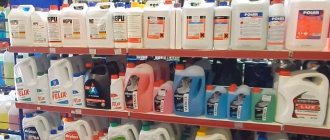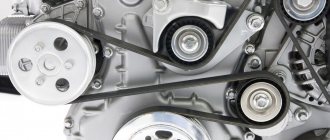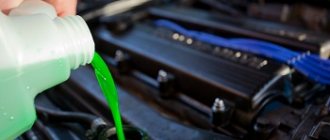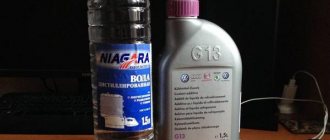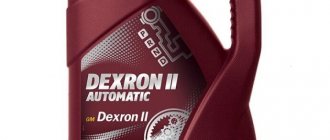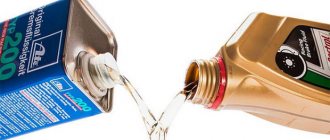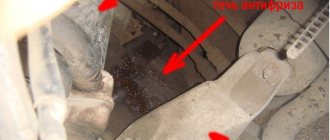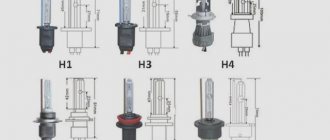Why does the engine need coolant?
In a running car engine, the temperature of the working gases in the cylinders is 800-900 °C. To prevent overheating of engine parts and their destruction, the car is equipped with a cooling system (hereinafter referred to as coolant). It uses cooling fluids called antifreeze.
In simple terms, antifreeze is a coolant for a car engine. A mixture of distilled water and poisonous alcohol. Its color is given by various additives that improve its qualities: they make it frost-resistant or increase the boiling point, reduce corrosion, etc.
Automotive antifreeze is produced by mixing special alcohol - ethylene glycol or ether - propylene glycol with highly purified water. Plus a package of additives that prevent corrosion of the cooling system pipes, pump (pump), cooling radiators and interior heater.
Ethylene glycol in antifreeze prevents it from freezing in cold weather and boiling away in the warm season.
Types of liquids for the cooling system
Over time, most European brands adopted a single classification, according to which the consumer can choose the required antifreeze based on color. But when choosing, it is recommended to pay attention to the markings, which must be applied to each package. Today there are 3 main designations:
- G 11 is most often green in color and is considered ordinary in its properties.
- G 12 and G 12+ are in most cases painted red and are considered a modified version of the previous generation. New additives are used in production, which guarantee unique characteristics.
- G 13 can be colored violet or yellow. Today it is considered to be the most reliable and high-quality. It is very popular among car owners. Created by Volkswagen.
Antifreeze labeled G 13 was first colored purple. Later, yellow or orange liquids with similar properties appeared on sale. The color change was due to a patent, but the characteristics of yellow antifreeze were no different from its purple counterpart. The German concern was very afraid of counterfeits , so it reserved the right to use the color purple.
What color are antifreezes?
In stores you can see red, green, blue and even yellow and purple antifreeze. I can assure you that the quality of the coolant does not directly depend on its color.
Dyes give antifreeze its color, and additives give it its beneficial properties. The composition of which is agreed upon between its manufacturer and consumers, that is, automobile companies that produce certain brands of cars.
For example,
- at FORD factories, orange antifreeze is poured into the cooling system,
- GM-Opel uses pink,
- in our native AvtoVAZ - red,
- for VOLVO cars – yellow.
The bright color of antifreeze makes it easy to control its level in the cooling system using the MIN and MAX marks on the walls of the expansion tank. It is necessary to monitor the coolant level as carefully as the engine oil level. The health of your car's engine directly depends on this, and as you know, it is the heart of every car.
There are antifreezes with fluorescent coloring for quickly identifying the location of a leak in the rays of a fluorescent lamp. The holes through which coolant leaves the system can be microscopic cracks. The fluid level in the reservoir drops, and it is extremely difficult to understand where the leak is occurring. In this case, the task becomes easier.
Watch the video - what color antifreeze is and how to choose it correctly.
Antifreezes are divided into 4 classes, based on the composition of the additives added to them:
- Class G11+, G11 – hybrid.
- Class G12+, G12 – carboxylate.
- Class G12++, G13 - lobrid.
- Class "Antifreeze" - traditional.
Let's look at them in order.
General tips for use
In order for antifreeze to bring maximum benefit to the car and not upset the car owner, you should know a few rules that will be useful for any type from the Felix line.
When purchasing coolant, the first thing you need to pay attention to is the authenticity of the product.
The original product can be distinguished by the following information on the packaging:
- There should be a transparent measuring strip on the side of the canister, with which it is convenient to control the volume of filled and remaining liquid.
- Marking in accordance with GOST 28084–89 is required.
- A readable label with the following information: main characteristics of the product, composition, specifications, as well as manufacturer’s contacts (full address and telephone number).
- Official company logo.
- The seller is obliged to show the product quality certificate at the buyer's request. If there is none, the authenticity of the product can be doubted.
Basic Rules:
- Never mix coolants of different types and compositions;
- before adding new antifreeze, the entire system must be thoroughly flushed;
- the liquid level in the expansion tank must always be within the appropriate mark (if necessary, refrigerant can be added);
- Under no circumstances should you drive a vehicle that has a refrigerant leak.
Car enthusiasts who have chosen antifreeze as a refrigerant admit that they have forgotten about the constant breakdowns and malfunctions of their car. Thus, affordable and high-quality antifreeze can not only extend the life of the vehicle, but also save a huge amount of the car owner’s nerves.
Hybrid
Inexpensive blue and green antifreezes are hybrid. In addition to synthetic additives, organic additives are also added:
- phosphates,
- silicates,
- nitrites.
Just a note
They give antifreezes anti-corrosion, anti-foam properties, guaranteeing against the appearance of insoluble sediment.
Hybrid coolants are the most common in our country. G11+ uses an improved additive package. The service life of such coolants is from 3 to 5 years.
The best of this class are considered to be domestic antifreezes Felix Prolonger G11, Sintec Euro and CoolStream Hybrid Extra.
Helpful information
Manufacturers of auto chemicals classify the entire former USSR as Europe, which is why we have a European antifreeze classification system. More precisely, not even European, but VAG. These are the same classes G11-G13 mentioned above.
Japanese antifreezes are also divided by color, but the color indicates the freezing point, not the composition or class. Red “Japanese” lasts up to -30 degrees, green - up to -25, yellow - up to -20.
In the USA there is no color policy. These are mainly red and green liquids containing nitrites. Nitrite antifreezes are prohibited for use in Europe. The closest substitutes for “Americans” are carboxylate antifreeze G12/13.
Russian “Tosol” comes in blue (operating temperature up to -40), green (under the G11 standard), red (operating temperature up to -50).
Carboxylate
Red antifreezes are classified as carboxylate antifreezes in the mid-price category. They contain additives based on carboxylic acids, which increase heat transfer and eliminate corrosion in the cooling system.
The service life of such coolants is more than 5 years. They are often used in the cooling system of engines of foreign cars with high mileage. G12+ uses an advanced additive package.
The most popular antifreezes in this class are Sintec LUX G12, Luxe G12+ Antifreeze Long Life and FELIX Carbox G12+.
The best brands
Finding a suitable liquid among all the variety of manufacturers is not easy. Choosing an option depending on the price category is not always correct, since some American or Japanese manufacturers may be inferior in quality to European ones, but are more expensive due to transportation. You can purchase the cheapest analogues, since the chemical composition of most liquids is very similar, but the likelihood of encountering a fake is extremely high. Proven brands that will not cost very much:
- Totachi long life antifreeze. The main advantage of this antifreeze is the complete absence of inorganic inhibitors. Produced in Japan, but its cost is low. The good quality of the additives used allows us to guarantee excellent characteristics: boiling occurs at a temperature of at least +106oC, and the liquid crystallizes at -37oC. The only negative point is the impossibility of use in regions where winter temperatures drop to extremely low levels.
- Felix Garbox. The Russian manufacturer is well acquainted with the requirements for coolant that are imposed on the territory of the Russian Federation. Unique additives used in production ensure full functioning of the engine at temperatures below -45°C. Combined with its low cost, this antifreeze model occupies a leading position in the domestic market.
- Liqui Moly Kuhlerfrostschutz KFS 2001 Plus is one of the most expensive options. The cost of a famous brand is 3-4 times higher than the price of competitors.
The vast majority of modern manufacturers guarantee high quality products. The only danger is from fakes, which can be difficult to distinguish from the original. When purchasing, you should pay attention to the label: if the information contains errors, typos, or the sticker is very easily removed from the packaging, then it is better to refuse such products.
Lobridaceae
Lobrid antifreezes first appeared in 2008. These are expensive coolants based on propylene glycol ether with a new balanced composition of organic and mineral additives.
This coolant is non-toxic and environmentally less harmful than antifreeze with ethylene glycol.
- Their service life is more than 5 years.
- Their composition is suitable for most modern engines, including turbocharged ones.
- They are pink and purple in color.
Lobrid antifreezes are still used less frequently than coolants of the first two classes, mainly due to their cost. But they are the future. These are liquids such as: Sintec UNLIMITED G12++ and CoolStream G13.
Why are additives needed at all?
Now, probably, many people are thinking - why are these additives needed at all, because antifreeze consists of ethylene glycol + water, everything seems to be great! Doesn't boil or freeze! Why are additives still there?
I wondered this too, and here's what I get:
A mixture of ethylene glycol + water, for all its apparent perfection, is, to put it mildly, imperfect! The thing is, this liquid turns out to be extremely active! If you pour it into your car's cooling system , in a matter of months it will corrode all your rubber and metal pipes and pipes, destroy radiators and even the engine block! To curb their aggressiveness, scientists began to add various additives that prevent corrosion and other negative phenomena from appearing.
The additives are not the same; there is always a search for a more advanced one, which will be cheap and also effectively curb all the negative manifestations of antifreeze. To distinguish them, a universal solution was adopted - additives began to be painted in certain colors in order to distinguish the capabilities of liquids. Thus, the colors red, green or blue appeared.
Now in more detail.
Antifreeze
Antifreezes - (A 40, A 40M), the most common traditional antifreezes in Russia, in which only inorganic substances and their mixtures serve as additives.
Antifreezes were created back in the USSR for cooling domestically produced cast iron engines. They are gradually losing their popularity due to their low performance properties compared to antifreezes.
- The freezing point of antifreeze is 40 °C, and for modern antifreezes it is 42-45 °C.
- The boiling point of antifreeze reaches + 120-130 °C, while antifreeze has a maximum of +105-108 °C.
The additive package in antifreeze is minimal; it is more often prone to foaming. Therefore, it is not suitable for use in modern power units of foreign cars and new models of domestic cars.
The service life of antifreeze does not exceed 2 years and it must be replaced every 60 thousand kilometers. Modern antifreezes allow you to operate cars without problems up to a mileage of 100-120 thousand km.
The most proven antifreezes are Felix, Detroil and Antifreeze A-40.
Main characteristics
"Felix" is a product manufactured in the Russian Federation. The company began its work back in 1993 and after 15 years (in 2008) it passed the international technical quality certification ISO/TS16949.
Today, Tosol-sintez LLC is one of the recognized leaders specializing in the production of technical fluids for various brands and types of cars. The company successfully cooperates with many domestic and foreign automakers, supplying them with coolant, windshield washer and brake fluids.
Felix is an antifreeze that appeared on the market relatively recently, but its quality has already been appreciated not only by Russian car enthusiasts, but also by their colleagues from near and far abroad. The secret of such success lies in many factors, namely:
- the refrigerant is universal, which means it is equally effective in both small passenger cars and heavy-duty vehicles;
- independence from climatic conditions: antifreeze works perfectly at temperatures from -45 to +50 °C;
- increasing fuel efficiency due to stable operation of the engine, protected from overheating and hypothermia;
- operation in normal temperature conditions helps to increase engine power and at the same time prevents its rapid wear;
- Felix antifreeze contains high-quality monoethylene glycol, as well as anti-corrosion, cleaning, anti-foam and lubricating additives;
- quite reasonable price.
Is it possible to mix antifreezes?
No matter what anyone tells you, if you don’t want to check how strong and durable your car’s engine is, don’t mix antifreeze of different brands or different colors.
You can never tell in advance what kind of reaction the additives will have with each other and what amount of suspension will be formed as a result. All this will get into the system, clog the cooling system pipes and the pump.
As a result, you will end up with a boiling engine right on the highway. And, according to the law of meanness, at the most inopportune moment. Your car is filled with one type of antifreeze, so top it up. With a complete replacement, it is also advisable to do without experiments.
Important
You should not mix antifreezes of different classes and different colors, even if you think that the composition is approximately identical.
If the coolant level in your car has dropped slightly, you can replenish it with distilled water. But not for long. And then you need to purchase exactly the same antifreeze and add it to the system. Moreover, the added distillate will evaporate like ordinary water, only with less consequences in the form of scale.
If you do not know what antifreeze is used in your car (especially after purchasing a used car), do not delay replacing it. Delay can bring you a lot of problems, including engine overhaul.
Watch the video on this topic. What color is antifreeze, how does one coolant differ from another, and is it worth mixing them when adding them?
The difference between antifreeze and antifreeze and the possibility of mixing
So what is the difference between antifreeze and antifreeze?
By and large, only in their name and country of origin. It is generally accepted, since the times of the USSR, that antifreeze is produced in Russia, and antifreeze abroad. The same base and similarity of additives facilitates the smooth mixing of antifreeze and G11 antifreeze. It is not recommended to mix G12 fluids with antifreeze due to the difference in additives. Only in cases of emergency. Afterwards it is better to replace the fluid in full.
About the difference between antifreeze and antifreeze - video
Antifreezes of the G13 group are not completely compatible with antifreeze. The inorganic base of antifreeze and propylene glycol in G13 enter into a strong chemical reaction.
All types of antifreeze are presented on the market in the form of concentrates or ready-made coolants and, including antifreeze, are diluted only with distilled water according to the proportions specified in the instructions.
Attention!
Excess water lowers the boiling point and raises the freezing point.
Which antifreeze to choose
If you need to replace the coolant, then the question of which antifreeze to choose for your car is very important. It appears when purchasing a used car.
Since it is not always known for certain whether the previous owner used the coolant recommended by the manufacturer, or whether everything in the system has been changed and replaced a long time ago.
Attention
When replacing any coolant in a car, be sure to change it from the flushing system. This will save you from unpleasant surprises and unnecessary expenses.
There is a universal rule:
- The car radiator is copper or brass, buy red or pink antifreeze.
- Aluminum or duralumin – blue or green will do.
But it would be more correct to purchase an antifreeze whose brand is indicated in the owner's manual for your car.
If you use G12 class antifreeze, then that is the only one you can use. You don’t need to attach much importance to the color of the liquid.
Any color of coolant will protect your vehicle as long as it meets the manufacturer's specifications and tolerances. Which company to trust is your personal choice.
Table No. 1. Decoding the designations of coolants for foreign cars.
Briefly about FELIX antifreeze
This approach of the manufacturer ensured that the consumable material complies with all tolerances, according to the international certification system, and is indicated for safe use in almost all domestic and imported cars. In addition, these antifreezes from the Tosol-Sintez company can be considered safe from an environmental point of view (a more gentle formula for disposal) and from the point of view of human use. Even if the cooling system breaks down and liquid accumulates in the car’s interior, there will be no severe poisoning; the only signal for a breakdown will be a sweetish smell, characteristic of all coolants.
Positive consumer reviews are the only test of quality over time, and over five million such reviews are collected annually.
Antifreeze Felix carbox red
Red dye is used for its production. The red Felix carbox is considered the most common among car enthusiasts. This refrigerant is characterized by high technical characteristics and a formula for extended use without loss of performance qualities.
For cars equipped with pump units, Felix carbox is especially indicated, as it extends the life of the mechanism while increasing its performance. Felix Carbox red antifreeze is used for all modern foreign cars, with the exception of modern Audi, Volkswagen and Saab models. It is this antifreeze that can be used for these brands until 2008.
Antifreeze Felix Prolonger green
From the name it follows that this product is released with prolonged action. High refrigerant performance is achieved through an innovative formula and deep cleaning of the base in several successive stages. In addition to a high-quality stable base, Green Felix has a unique package of additives that are balanced with each other and are aimed at additional protection of the car.
The distinctive characteristics from analogues include increased thermal conductivity and excellent lubrication properties of even particularly thin passages, as well as the complete elimination of foam formation in operating mode. The coolant has passed more than one test and has only positive reviews from consumers, having proven in practice that it is capable of operating at any critical temperatures. Green color determines versatility of use and bypasses seasonal replacements. the manufacturer recommends using Felix Prolonger green for all modern car models from Smart, Deo and Volvo, as well as other concerns up to 1996 - 2005 (you need to check the approvals from the car manufacturer).
Antifreeze Felix Energy yellow
Felix Energy yellow antifreeze is a new generation of coolants.
Felix Energy yellow antifreeze copes well with all types of corrosion, scale and does not precipitate. It works flawlessly all year round, maintaining high thermal conductivity without constant replacement. The yellow dye is added to a mixture of high quality monoethylene glycol base and additive package. Indicated for use by the world's leading concerns without restrictions for all cars, from 2001 to the present day.
You may also be interested
At what temperature does antifreeze freeze?
Antifreeze is designed to resist low and high temperatures, remaining in the same consistency. It should not boil when the engine heats up and harden in cold weather. But for many drivers, despite all the tricks, antifreeze freezes in the cold season. Let's talk to experts about why this is happening?
High-quality antifreeze is a guarantee of safe operation of your car
Antifreeze refers to the coolant necessary for the functioning of a car engine. Antifreeze allows you to cool the structural components of a car engine to the required temperature, preventing their deformation and failure. Before the invention of antifreeze, ordinary water was used as a coolant, but the water circulating in the cooling circuit tended to freeze, and when it freezes, the water increases in volume. Water expansion […]
The color is different, the components are the same.
You may not be a “smart guy,” but at the same time you know very well what is included in any antifreeze. Its basis is ethylene glycol (ethanediol, propylene glycol), as well as distilled water, which accounts for quite a bit, as much as 80% of the total volume of liquid.
It is thanks to ethylene glycol that antifreeze acquires its ability to withstand high temperatures of up to 196 degrees. As for the ability not to freeze, things are worse here, because this substance begins to freeze already at minus 12 degrees. To solve this problem, water is added to antifreeze, which shifts the freezing threshold from 11 degrees to 65. In our vast country, it is very difficult to find regions in which the temperature drops below this mark.
Another important component of antifreeze is additives. They make up approximately 20% of the total volume of the liquid, but it is due to their “fault” that the liquid acquires its characteristic color. It can be green, blue or red. There is also purple and yellow antifreeze, but it is almost impossible to find it on sale here.
You probably have a question: is it possible to do without additives at all? The answer is no. After all, additives not only provide antifreeze with a certain color, but also perform another, much more important function, protecting the walls of the radiator and pipes from the aggressive effects of... the antifreeze itself. Yes, without additives, antifreeze would quickly begin to destroy these walls and simply would not work as it should.
After reading the above, you probably have even more questions than answers, so right now we will look at the issue of the need for additives in antifreeze in more detail.
How the cooling system works
During the combustion of fuel in the cylinders, a large amount of heat is released, most of which is lost along with the exhaust gases. The remaining heat is distributed between the piston, cylinder and cylinder head (cylinder head). Due to this, the temperature of the piston walls, cylinder block and cylinder head increases, which facilitates ignition of the fuel and improves its combustion. If the engine continues to heat up even after reaching the optimum temperature, the fuel will ignite earlier than necessary (detonation), which will cause the connecting rods, crankshaft, pistons, valves and cylinder head to begin to deteriorate. In addition, early ignition of the fuel will lead to a drop in engine power and deterioration in efficiency.
A further increase in temperature will lead to:
- the appearance of cracks in the cylinder head; destruction of valves and pistons;
- overheating of the oil and the resulting increase in wear of the crankshaft and liners;
- deterioration of the valve stem seals and oil entering the cylinders, which will lead to an even greater decrease in power and increased fuel consumption;
- a sharp decrease in the overall engine life; crankshaft jamming.
The pump (water pump) of the cooling system drives coolant through the channels. Thanks to this, the coolant washes the cylinder block and cylinder head, taking away excess heat. After this, the coolant enters the radiator, which blows the incoming air. Using a fan allows you to increase the efficiency of airflow. After cooling in the radiator, the coolant enters the cylinder block, rises to the cylinder head and cools the engine. The higher the engine speed, the more the pump impeller rotates and the faster the coolant moves through the channels of the cooling system.
Red antifreeze or G12
Even more advanced antifreezes appeared immediately after green. The additives needed are almost completely organic, that is, carboxylic acid is used in large quantities.
These additives do not form a film inside the pipes, which significantly improves heat dissipation. They perfectly localize corrosion spots, forming a 1 micron thick film on them. They also do not crumble after a certain time. These additives are much more advanced than, say, the previous generation.
- Improved heat dissipation
- Do not crumble
- Long lasting, service life up to 5 years
- Excellent localization of corrosion areas
Minuses:
- It seems that this is happiness - the additives are ideal, but there is one minus, and a significant one. They begin to fight pockets of corrosion, but do not protect or prevent the cooling system. This is a huge disadvantage of red antifreeze.
- Also, carboxylic acid does not protect aluminum radiators much, which also has a negative connotation; however, they protect copper and brass more strongly.
What is “ G12 +” and “ G12 + +”?
If you want, this is a hybrid, to exaggerate it is similar to “G11” - only here there is a smaller part of chemical reagents, for example silicates, but there are more organics (carboxylic acid). That is, if the additive itself is broken down into its components, you get 80 - 90% carboxylic acid and 10 - 20% silicates.
Is it possible to use different liquid standards together?
You can combine different tones of automotive antifreeze when they belong to a single standard. For example, it is allowed to add blue antifreeze with a similar marking to green coolant G11. You can also mix antifreeze with each other, and antifreeze of the same group, orange in color, is suitable for substance G13 of a purple hue.
It is important to understand the principle of harmonization of coolant standards. Classes G11 and G12 include ethylene glycol, and G13 antifreeze contains propylene glycol. These are completely opposite alcohol compounds, mutually exclusive. In all countries, the name of the standard may differ:
⦁ in the USA these are ASTM and SAE;
⦁ in Britain - BS;
⦁ in Italy - CUNA;
⦁ in France - AFNOR;
⦁ in Australia - ONORM, etc.
The American version of the mark is most widespread. All countries inform through standards about climatic features, the nuances of cooling mechanisms and the characteristic qualities of cars of various brands.

